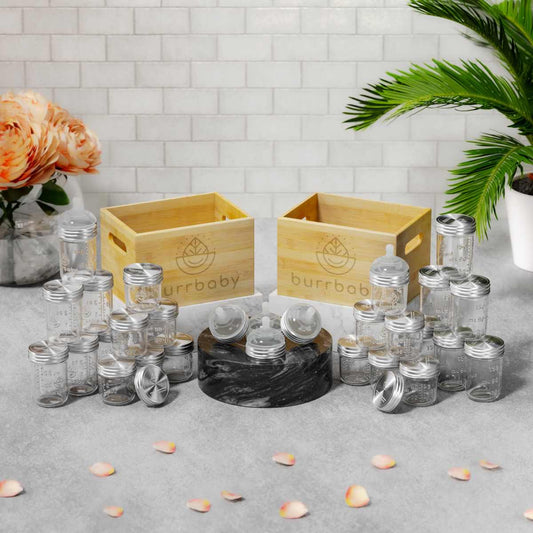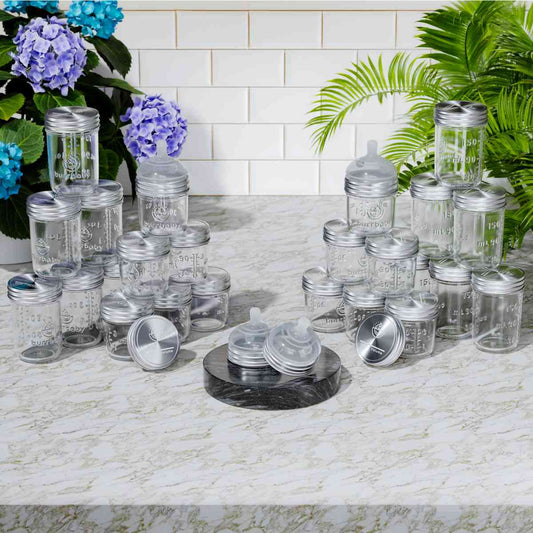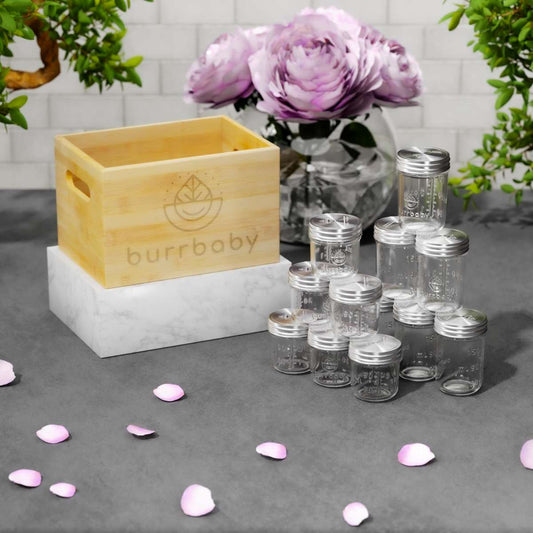As you embark on your parenting journey, you might be feeling a mixture of excitement and perhaps you might be a little overwhelmed (which is totally normal).
With the growing concerns about the impact of chemicals in plastics and other chemicals on child development, many new parents are exploring healthier, eco-friendly alternatives for their baby's nursery.
In this article, you'll discover some simple yet effective, sustainable practices that will help you create a healthy, eco-friendly nursery.
Article Overview
- Crafting the perfect green space for your baby
- Energy Efficiency and Indoor Air Quality
- Safe and Sustainable Toys
- Eco-friendly diapering options
- Recycling and upcycling nursery items
At Burrbaby, we're dedicated to being a part of a healthier world for your children. We do this through our zero-plastic glass breast milk storage containers and bottles. These completely non-toxic, sustainable choices protect your baby's health and our planet.
Crafting the perfect green space for your baby
Creating a safe and nurturing space for your little one begins with selecting the right furniture and materials. The choices you make will not only impact your baby's well-being but also contribute to a healthier environment.
Sustainable wood or bamboo options
It's important to search for furniture crafted from sustainably sourced wood, such as Forest Stewardship Council (FSC) certified or reclaimed wood. This ensures that the wood comes from responsibly managed forests or is repurposed, reducing deforestation and promoting better environmental practices.

If these prove to be difficult to find, any furniture made from solid wood is still a better option than plastic or composite materials. Plastic and composite materials both contain many additives that are not sustainable and could potentially cause unwanted exposure to synthetic chemicals.
Bamboo is also sustainable due to its rapid growth rate, often outpacing other trees, allowing for frequent harvesting without causing deforestation. Its cultivation is generally free of chemicals and pesticides, making it a clean, eco-friendly crop. Moreover, bamboo's extensive root system can help control soil erosion and regenerate degraded lands, contributing to a healthier environment.
Burrbaby follows these practices as well, including an FSC-Certified Bamboo Storage Box to organize and keep stored breast milk safe, which is a much healthier and more sustainable choice when compared with the commonly available plastic storage systems.
Non-toxic paint and finishes
Paints and finishes can release volatile organic compounds (VOCs) that may negatively affect your baby's health. When choosing paints for your nursery, choose low or non-VOC paints and water-based, non-toxic finishes to minimize this risk. These alternatives safeguard your baby's respiratory health and contribute to improved indoor air quality.
Look for paints with the Greenguard label, as those have been 3rd party tested for VOC content. Brands such as ECOS, AFM Safeguard, Clare Paint, and Sherwin-Williams Harmony are all solid choices.
Burrbaby utilizes a vegetable based finish on its bamboo box for storing and organizing breastmilk storage and its glass baby bottles.
Organic and natural textiles
Another aspect to consider is to wrap your little one in soft, comforting textiles made from organic cotton, bamboo, wool or hemp. These natural materials are gentle on your baby's skin and produced without harmful chemicals, making them a responsible choice for the environment.
Look for certifications like Global Organic Textile Standard (GOTS) to ensure the materials meet stringent environmental and social criteria.
By choosing sustainable furniture and materials, you're giving your child the best start possible while showing respect for the environment.
Energy Efficiency and Indoor Air Quality
Let's dive into some aspects to consider when designing your nursery with energy efficiency and indoor air quality in mind.

Energy-saving lighting solutions
When designing your nursery, it's best to choose energy-efficient lighting, such as LEDs or CFLs, which save energy and last longer than traditional incandescent bulbs. You might also consider incorporating dimmable options to create a calming atmosphere during nighttime feedings and diaper changes. Additionally, choosing warmer shades of light bulbs can be more comforting to the eyes.
Proper ventilation and air purifiers
Fresh air is vital for your baby's well-being. Ensuring proper ventilation in the nursery helps reduce indoor air pollutants and enhances air quality. The ultimate solution is to install an air exchange system in your home that cycles fresh air from outside your home through your HVAC system.
If that is not a possibility, regularly opening windows, even for a short period, can significantly improve air circulation. We recommend investing in an air purifier with a HEPA filter to remove airborne contaminants and allergens that could impact your baby's health is something you might consider.
Indoor plants and green cleaning products
Nature offers a myriad of solutions to improve air quality. For example, incorporating houseplants into your nursery can help purify the air by filtering out volatile organic compounds. Choose low-maintenance, child-friendly options such as Spider Plant, Snake Plant, Peace Lily, Pothos, or Aloe Vera. These plants also enhance the visual appearance of the nursery at the same time! We love the aesthetic of our indoor plants.
Moreover, look for green cleaning products free of harsh chemicals and fragrances, reducing your baby's exposure to airborne chemicals.
Taking these steps to enhance energy efficiency and indoor air quality will ensure a healthier environment for your child.
Safe and Sustainable Toys

Providing a healthy, nurturing environment for your baby goes beyond just their nursery – it extends to selecting safe and sustainable toys.
Head here to learn more about eco-friendly toy options.
Wooden and cloth toys: steering clear of plastic when possible
Research has shown that plastic toys can harbor harmful chemicals such as phthalates and bisphenols. These substances can potentially interfere with your child's development and when disposed of, will leak into the environment.
To minimize this risk, choose wooden or cloth toys made from sustainable materials, like FSC-certified wood, organic cotton, wool, or natural fibers like hemp. Wooden toys, for example, are durable and biodegradable, making them an excellent eco-friendly alternative.
It's also important to pay attention to the paint used. Kids chew on everything which makes it crucial to ensure we avoid plastics and that paint is used sparingly on their wood toys.
Proper storage and cleaning practices for toys
Keeping your child's toys clean and well-organized is essential to maintaining a healthy, eco-friendly nursery. Store toys in containers made of sustainable materials, such as wood, bamboo, or woven baskets to minimize exposure to potentially harmful chemicals in some plastics. Regularly cleaning toys with green cleaning products can also help reduce the buildup of germs and bacteria without introducing harsh chemicals into your baby's environment.
By making informed choices when picking your child's toys and following proper storage and cleaning practices, you can ensure that your little one grows up in an environment that promotes both their well-being and the planet's.
Head here to read more about how to incorporate more eco-friendly parenting practices.
Eco-Friendly Diapering Options
Many new parents grapple with the choice between conventional disposable diapers and more eco-friendly alternatives when it comes to diapering. Thankfully, several options cater to those committed to creating a healthier, more sustainable environment for their babies.
Cloth Diapers vs. Disposable Diapers
Cloth diapers, a classic and environmentally conscious choice are resurging among eco-savvy parents. These reusable diapers cut down on waste and save you money in the long run. Cloth diapers can be made from natural materials such as cotton, bamboo, and hemp to ensure your baby's sensitive skin is swaddled in gentle fabric.
There are also much better cleaning systems available now than in the early days.
For parents keen on reducing their ecological footprint but deterred by the extra laundry, there's good news: modern cloth diapers are simple to use and maintain. In addition, with an array of styles, colors, and fastening mechanisms available, today's cloth diapers provide a personalized solution for eco-friendly diapering.
Biodegradable Disposable Diapers
If cloth diapering seems daunting, biodegradable disposable diapers provide another green alternative. These eco-friendly disposables are crafted from plant-based materials, often boasting chlorine-free processing, and decompose faster than conventional diapers. So while they might be pricier, they offer a more convenient and environmentally friendly option for parents on the go.
At the very least, try to choose a diaper brand that uses as few chemicals as possible in their diapers, even if they aren't reusable or biodegradable.
Choosing eco-friendly diapering options contributes significantly to creating a healthy, sustainable nursery.
The Lasting Impact of an Eco-Friendly Nursery
Research highlights the long-term benefits of reducing exposure to toxic chemicals and plastic materials in early life stages. By making informed, environmentally conscious choices, you create a safer space for your little one and contribute to preserving our planet for future generations.
References:
Braun, J. M., Just, A. C., Williams, P. L., Smith, K. W., Calafat, A. M., & Hauser, R. (2014). Personal care product use and urinary phthalate metabolite and paraben concentrations during pregnancy among women from a fertility clinic. Journal of exposure science & environmental epidemiology, 24(5), 459-466. https://pubmed.ncbi.nlm.nih.gov/24149971/
EcoWatch https://www.ecowatch.com/
U.S. Environmental Protection Agency. Reduce, Reuse, Recycle. https://www.epa.gov/recycle
Yue B, Sheng G, She S, Xu J. Impact of Consumer Environmental Responsibility on Green Consumption Behavior in China: The Role of Environmental Concern and Price Sensitivity. Sustainability. 2020; 12(5):2074. https://doi.org/10.3390/su12052074
Grant, K., Goldizen, F. C., Sly, P. D., Brune, M. N., Neira, M., van den Berg, M., & Norman, R. E. (2018). Health consequences of exposure to e-waste: a systematic review. The Lancet Global Health, 1(6), e350-e361. https://pubmed.ncbi.nlm.nih.gov/25104600/
Greenpeace. https://www.greenpeace.org/international/
Real Diaper Association https://realdiaperassociation.org/
Siegle, L. (2019). Turning the tide on plastic: How humanity (and you) can make our globe clean again. Trapeze. https://www.amazon.com/Turning-Tide-Plastic-Humanity-Globe/dp/1409182983
Braun, J. M., Kalkbrenner, A. E., Calafat, A. M., Yolton, K., Ye, X., Dietrich, K. N., & Lanphear, B. P. (2016). Impact of early-life bisphenol A exposure on behavior and executive function in children. Pediatrics, 128(5), 873-882. https://pubmed.ncbi.nlm.nih.gov/22025598/
Environmental Protection Agency – Identifying Greener Cleaning Products https://www.epa.gov/greenerproducts/identifying-greener-cleaning-products
Rochester, J. R. (2013). Bisphenol A and human health: A review of the literature. Reproductive Toxicology, 42, 132 https://pubmed.ncbi.nlm.nih.gov/23994667/
Heather L. Brumberg et al.; COUNCIL ON ENVIRONMENTAL HEALTH, Ambient Air Pollution: Health Hazards to Children. Pediatrics June 2021; 147 (6): e2021051484. 10.1542/peds.2021-051484 https://publications.aap.org/pediatrics/article/147/6/e2021051484/180283/Ambient-Air-Pollution-Health-Hazards-to-Children
ENERGY STAR. www.energystar.gov
American Lung Association. Clean Air. https://www.lung.org/clean-air
Wolverton, B. C., Johnson, A., & Bounds, K. (1989). Interior landscape plants for indoor air pollution abatement. NASA. https://ntrs.nasa.gov/citations/19930073077
Green Cleaning, Sanitizing and Disinfecting: A Toolkit for Early Care and Education https://wspehsu.ucsf.edu/main-resources/green-cleaning-sanitizing-and-disinfecting-a-toolkit-for-early-care-and-education/
Forest Stewardship Council. https://fsc.org/en/businesses/wood
EPA (2021). Volatile Organic Compounds' Impact on Indoor Air Quality. U.S. Environmental Protection Agency https://www.epa.gov/indoor-air-quality-iaq/volatile-organic-compounds-impact-indoor-air-quality
The Importance of Using Low VOC Paints. Earth911. https://earth911.com/home-garden/what-are-vocs-and-how-can-you-avoid-them/
GOTS (2021). Global Organic Textile Standard (GOTS). Retrieved from https://www.global-standard.org/
Street, M. E., & Bernasconi, S. (2021). Microplastics, environment and child health. Italian Journal of Pediatrics, 47, 75. doi: 10.1186/s13052-021-01027-9. https://ijponline.biomedcentral.com/articles/10.1186/s13052-021-01034-3










